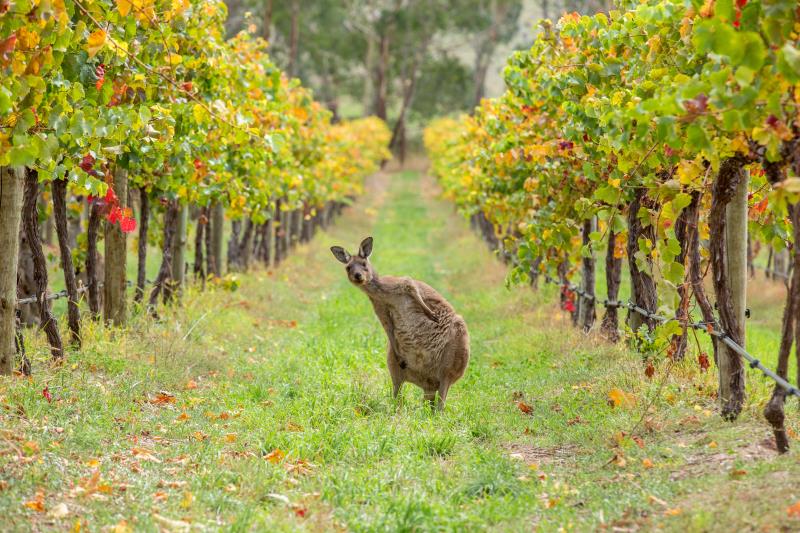New South Wales wine region is one of the major wine regions of Australia with diverse sub-regions spread over 800,000 km2 in this large southern state. Its best-known sub-region is Hunter Valley, which happens to be the oldest wine region in Australia, however, there are several sub-regions in its ever-expanding wine territory. There are producers of quality and quantity in New South Wales and boutique operations are seeing a boost due to the steady influx of wine tourists coming mainly from Sydney. What is New South Wales wine region all about? We look at the soils, climate, history, winemaking and the quintessential terroir of New South Wales wine region and sub-regions in this guide.
Where is it?
This is the easternmost region of Australia in the vicinity of Sydney and Canberra.

Credit: Wine Australia
Latitude
Cowra 33˚S
Longitude
Cowra 148˚E
Altitude
Between 70 and 1320 masl (the latter being New England, Australia’s highest wine region).
Main regions and appellations

Aerial view of the Hunter Valley Photo credit: Kimberley Low Wine Australia
Hunter Valley wine region guide
The Hunter Valley is a 2,000-hectare area of vineyards just 160km from Sidney. It is known for its extensive cloud cover, which moderates the high summer temperatures. This, Australia’s oldest wine-producing region, has flourished because of its proximity to Sydney, facilitating links with domestic and export markets and making it an attractive tourist destination.
There are some old vines here, mainly of Shiraz and Sémillon, which produce some particularly concentrated wines. To the south of the region, in the foothills of the Brokenback Ridge, are some areas of weathered basalt, which naturally reduces vine vigour, resulting in interesting wines, including some good Shiraz, which accounts for 29% of the grapes grown in the region.
Sémillon accounts for 31% of the grapes grown in the Hunter Valley and this region is well-known for its own particular style of Sémillon wine. Picked with low sugar levels and high acidity, the wine is bottled young but ages very well. Chardonnay, Verdelho, Tempranillo and Cabernet Sauvignon are also grown in the Hunter Valley.
Mudgee wine region guide
This is a cooler district because of its higher altitude on the slopes of the Great Dividing Range. It is known for Chardonnay, Cabernet Sauvignon, Riesling and Shiraz.
Orange wine region guide
Orange has 1,127 hectares of vineyards planted at altitudes of up to 1390 masl. This means cool night-time temperatures and so the wines produced in Orange are naturally high in acidity. The top varieties grown here are Shiraz (28%), Chardonnay (19%) and Cabernet Sauvignon (15%). It also produces some fresh, lean Riesling and Sauvignon Blanc wines.
Cowra wine region guide
With 647 hectares of vineyards at moderate altitudes (262-527masl), Cowra is especially known for producing good Chardonnay wine and this variety accounts for 40% of the grapes grown there, followed by Shiraz at 23%.
Hilltops wine region guide
This area is at a slightly higher altitude and is planted with red varieties, Chardonnay and Sémillon. Mostly, the grape-growers sell the grapes to producers that make the wine elsewhere, so the region is less well-known.

Lerida Estate Vineyard, Canberrra Photo credit: Kimberley Low Wine Australia
Canberra District wine region guide
Close to the capital, the vineyards are located at altitudes of 500-800masl and have a good diurnal range with warm days and cold nights. In winter, temperatures drop significantly and frost can be a problem. Here Pinot Noir, Riesling and Grüner Veltliner can be found, along with Chardonnay, Shiraz and Viognier.
Shoalhaven Coast and Hastings River wine region guide
Both areas suffer from high humidity and are experimenting with hybrids.
Tumbarumba wine region guide
This is a cool, high-altitude region and it specializes in Chardonnay for still and sparkling wines.
Riverina wine region guide
This is the biggest wine-producing area in New South Wales. This area was populated by immigrants from Europe after the two World Wars and they and their descendants really paved the way for the large-scale wine industry that is there today. Riverina, together with Murray-Darling and Riverland, forms part of the appellation South Eastern Australia and has a name for large-scale, efficient production of grapes for bulk wines. However, more recently, innovative producers from Riverina have been garnering a reputation for very special wines, including botrytized Sémillon, and have been experimenting with Mediterranean varieties like Durif.
Climate
New South Wales has a sub-tropical climate with very hot summers and wet autumns. The northeast winds from the Pacific counteract the heat somewhat and in the Hunter Valley the frequent cloud cover helps stop grapes from being sunburnt. Most of the 750mm of annual rainfall falls between January and April, the worst possible time for the ripening grapes and harvest period.
Producers have increasingly sought out areas at higher altitudes so that the climate is cooler and the grapes ripen more slowly and evenly without losing their acidity. Australia’s highest vineyards are in New South Wales.
Temperatures
The mean January temperature ranges from 21.6˚C in Orange through to 25.7˚C in Riverina.
Rainfall
This varies substantially across the sub-regions. For instance Hunter Valley has an annual average of 774mm, while Riverina has just 404mm.
Climate change and drought in New South Wales
Producers across Australia are talking about climate change and its impacts and many are experimenting with new varieties that will better cope with warmer, drier conditions, particularly those originating in warmer countries, such as Spain, Portugal and Italy.
Recent years have also seen significant times of drought, particularly for the warm inland areas like Riverina and its neighbouring regions of Riverland and Murray-Darling, which irrigate using water from a large river basin supplied by snow runoff from the Snowy Mountains. However, during the last few decades, the water reserves have dropped hugely and irrigation has become financially unviable for some growers, leading to some vineyards being grubbed up.
In 2018, the whole of New South Wales was officially declared as in drought, with some areas in extreme drought and grape yields significantly down and the government having to provide financial help to affected producers.

Briar Ridge Vineyard, Hunter Valley. Photo credit: Mike Jeffery Wine Australia
Soil and topography
The Hunter Valley has gently rolling terrain with sandy alluvial soils, alluvial clay loams and some volcanic soils.
Grape varieties in New South Wales
Shiraz
Shiraz is planted in almost every Australian wine region and between them they have 39,900 hectares of this variety. The Hunter Valley is well-known for its Shiraz, which tends to be medium-bodied with red fruit and savoury character.
Pinot Noir
The difficult to grow and difficult to vinify variety that producers around the world love to hate, Pinot Noir, is also planted in New South Wales, mainly in the higher-altitude, cooler regions.
Cabernet Sauvignon
Like Shiraz, Cabernet Sauvignon has been extensively planted in Australia and the wines that are made vary significantly in style. This variety is a late-ripener and needs a certain degree of warmth to ripen fully. The Hunter Valley is one of the areas where it is grown.
Sémillon
Sémillon from the Hunter Valley is a particular style. Picked with low sugar levels and bottled young, Hunter Valley Sémillon has crisp acidity and citrus aromas and flavours that pair well with seafood. With age these wines develop complex toast, vanilla and honey flavours, giving them depth and richness.
Chardonnay
Cool-climate zones at higher altitudes like Mudgee, Orange, Hilltops, Canberra District and Tumbarumba produce Chardonnay grapes with fresh acidity for still and, in some cases, sparkling wines, while the grapes grown at lower altitude (and therefore warmer) vineyards in Hunter Valley and Cowra will make richer, fuller-bodied and higher alcohol Chardonnays.
Verdelho
This white variety is originally from Madeira, but has taken well to Australia. The Hunter Valley is particularly known for it, producing vibrant, full-bodied wines.
Riesling
Australia has gained global renown for its Riesling wines, especially from the legendary Clare and Eden Valleys. However, some of the cooler, higher altitude areas of New South Wales are also making a name for themselves with this crisp, high-acidity white with its classic citrus aromas, like limes, which evolve into kerosene and honey aromas with age.
Sauvignon Blanc
This high-acidity, aromatic white variety is among the world’s favourites and there are modest plantings of it in some of New South Wales’ cooler areas, like Orange, where the cool temperatures enable slow ripening and the development of its citrus fruit aromas, while retaining the variety’s classic refreshing acidity.
Viognier
With its exotic aromas of rose petals, grapes, apricots, peaches and ginger, Viognier is a variety that can really excite the senses. It needs some warmth to ripen fully and reveal all those seductive aromas, which in turn means that acidity can fall a little and the alcohol level be quite high. The Canberra District is one area producing this variety.
Grüner Veltliner
This peppery variety more usually associated with Austria has found its fans in Australia (especially Adelaide Hills) and there are a few plantings in the Canberra District, where cool nights help the grapes retain their acidity.
Viticulture facts and vineyard management in New South Wales
Planting density and vine training systems
80% of the grapes in Australia are machine-harvested and many other vineyard tasks are also mechanized. Therefore planting densities and training systems are firstly designed to enable machinery to pass along rows, with canopies and clusters of grapes uniformly organized for ease of work.
Australia has been at the forefront of research into training systems and canopy management techniques and producers use those that work best for their varieties, terrain and climate.
Irrigation
Irrigation is essential in many parts of Australia and, with recent droughts, drip-irrigation is increasingly common.
Pests and diseases
Eutypa dieback (ED) and Botryosphaeria dieback (BD) are major trunk diseases in Australia, as elsewhere around the world, causing significant yield reduction and are regarded as among the most serious diseases facing Australian producers.
Botrytis is a significant problem in the cooler regions of New South Wales, such as Canberra.
Yields
15 tonnes per hectare, the highest in Australia.
Winemaking and wine styles
Australian wine producers, like those in many New World Countries, are free to make the styles of wine they wish from the varieties they choose. The range of wines currently being produced in New South Wales is very wide. Whites include dry and sweet wines from Sémillon, Chardonnay in all styles and refreshing, lighter-bodied Sauvignon Blanc and Riesling. Red wines come in many styles too, from light-bodied and fresh Pinot Noir through medium-bodied, fruity Cabernet Sauvignon to oak-aged, meaty Shiraz.
Traditional wine pairing
Check out Hunter Valley Sémillon with seafood, botrytized Sémillon from Riverina with a pear or peach-based dessert or Shiraz with a good Australian barbecue.
Trade/commercial factors
Wine production area of New South Wales
33,634 hectares in 2015
Number of wine producers in New South Wales
967 wine businesses in 2015
Family businesses account for 75% of the total crush in New South Wales.
However, this region is also home to 8 of Australia’s Top 20 wine producers and 7 of its Top 20 exporters.
Annual production
2015: 495,789 tonnes.
Interesting facts
Kangaroos are a very Australia-specific vineyard problem; when hungry, they will gorge on the grapes hanging on the vines and can strip a vineyard of its crop in a couple of nights.
Sources
Wine Australia – who kindly provided the photos and maps used in these articles.
Upper Hunter Valley Viticultural Profile
General statistics:
Australian Bureau of Statistics

